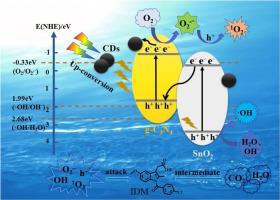Journal of Hazardous Materials ( IF 12.2 ) Pub Date : 2020-06-21 , DOI: 10.1016/j.jhazmat.2020.123257 Daguang Li 1 , Jiaxing Huang 2 , Ruobai Li 1 , Ping Chen 3 , Danni Chen 1 , Meixuan Cai 1 , Haijin Liu 4 , Yiping Feng 1 , Wenying Lv 1 , Guoguang Liu 1

|
As an emerging carbon nanomaterial, carbon dots (CDs) have superior prospects for applications in the area of photocatalysis due to their unique optical and electronic properties. In this study, a novel CDs modified g-C3N4/SnO2 photocatalyst (CDs/g-C3N4/ SnO2) was successfully synthesized by the thermal polymerization. Under visible light irradiation, the resulting CDs/g-C3N4/SnO2 photocatalyst exhibited excellent photocatalytic activity for the degradation of indomethacin (IDM). It was demonstrated that a 0.5 % loading content of CDs led to the highest IDM degradation rate, which was 5.62 times higher than that of pristine g-C3N4. This improved photocatalytic activity might have been attributed to the unique up-conversion photoluminescence (PL) properties and efficient charge separation capacities of the CDs. Moreover, the combination of g-C3N4 with SnO2 improved the separation of photoinduced carriers and augmented the specific surface area. Reactive species (RSs) scavenging experiments and electron spin resonance (ESR) revealed that superoxide radical anions (O2·−) and photogenerated holes (h+) played critical roles during the photocatalytic process. The results of the detection of H2O2 and ESR confirmed that CDs/g-C3N4/ SnO2 was a Z-scheme heterojunction photocatalyst. Further, HRAM LC–MS/MS was employed to identify the byproducts of IDM, and the major IDM degradation pathways of the CDs/g-C3N4/SnO2 photocatalyst were proposed. This study provides new ideas for the design of novel CDs modified photocatalysts for environmental remediation.
中文翻译:

碳点修饰的g-C3N4 / SnO2 Z型光催化剂的合成具有优异的光催化活性,可在可见光照射下降解PPCPs。
作为新兴的碳纳米材料,碳点(CD)由于其独特的光学和电子特性,在光催化领域具有广阔的应用前景。在这项研究中,通过热聚合成功地合成了一种新型的CDs改性的gC 3 N 4 / SnO 2光催化剂(CDs / gC 3 N 4 / SnO 2)。在可见光照射下,得到的CDs / gC 3 N 4 / SnO 2光催化剂对吲哚美辛(IDM)的降解表现出优异的光催化活性。结果表明,0.5%的CD负载量导致最高的IDM降解率,是原始gC 3 N 4的5.62倍。这种提高的光催化活性可能归因于CD独特的上转换光致发光(PL)特性和有效的电荷分离能力。此外,gC 3 N 4与SnO 2的组合改善了光诱导载流子的分离并增加了比表面积。反应物种(RSs)清除实验和电子自旋共振(ESR)显示超氧自由基阴离子(O 2·-)和光生空穴(h +)在光催化过程中起关键作用。H 2 O 2和ESR的检测结果证实CDs / gC 3 N 4 / SnO 2是Z-方案异质结光催化剂。此外,HRAM LC-MS / MS用于鉴定IDM的副产物,并提出了CDs / gC 3 N 4 / SnO 2光催化剂的主要IDM降解途径。这项研究为设计用于环境修复的新型CD改性光催化剂提供了新思路。











































 京公网安备 11010802027423号
京公网安备 11010802027423号